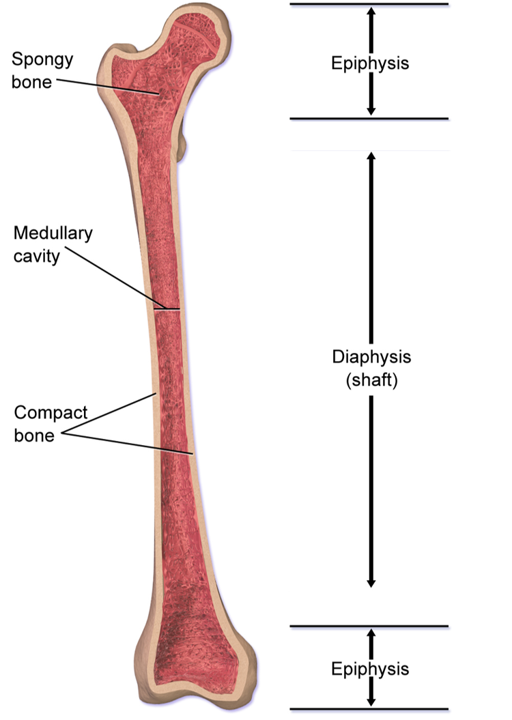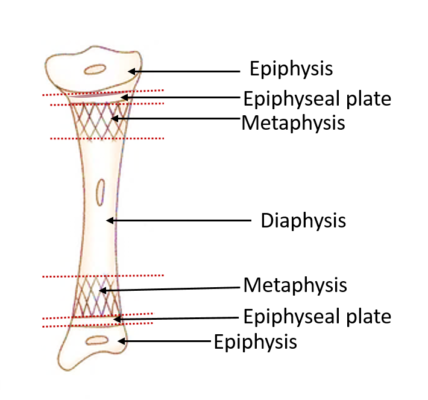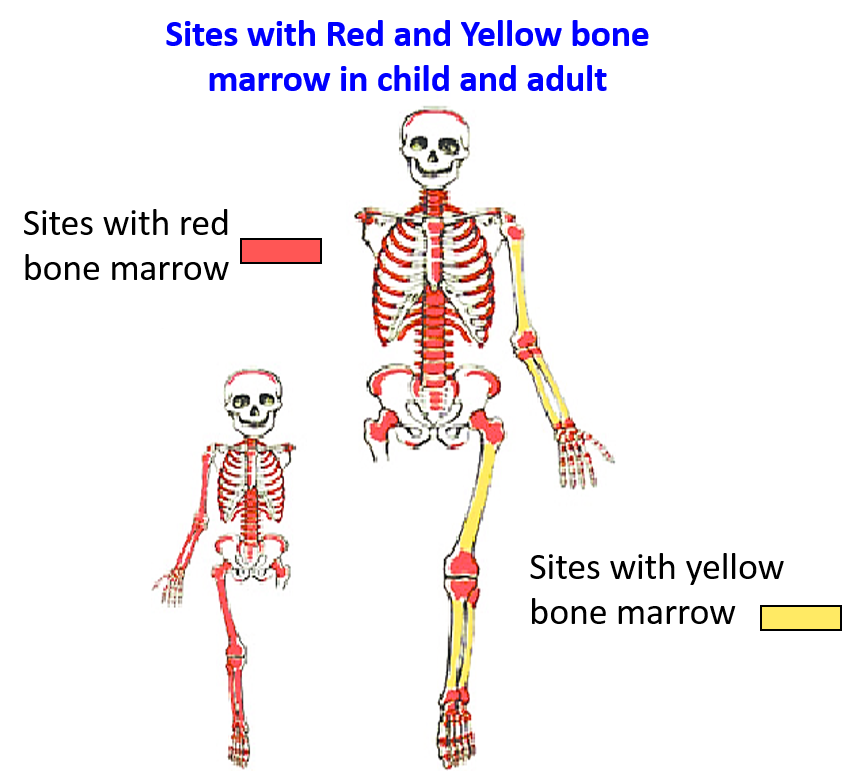Bone is a specialised connective tissue, its matrix is impregnated with calcium salts (mainly calcium hydroxy-apatite [CA10(PO4)6(OH)2]. It is highly vascular and has great regenerative power. There are total of 206 bones in adults.
Features of a Typical Long Bone
- Their length exceeds the breadth.
- They are weight bearing.
- A long bone presents a shaft and two ends.
- The shaft ossifies from primary center of ossification (appears before birth) and ends ossify from secondary centers of ossification (usually appear after birth, except lower end of femur and upper end of tibia, where secondary center of ossification appears just before birth).
- The shaft consists of tube of compact bone which contains medullary cavity filled with bone marrow.
- The shaft usually has 3 surfaces separated by 3 borders.
- They ossify in cartilages.
- Examples – humerus, femur, radius, ulna, tibia, fibula.

Parts of Developing Long Bone
Following are the parts of a developing long bone are:
Epiphysis: The ends of long bones that ossify from the secondary centre of ossification are called epiphysis. Epiphyses are made of spongy bone covered by a thin layer of compact bone.
Diaphysis: The elongated, cylindrical shaft of long bone that ossifies from the primary centre of ossification. It is made up of compact bone and encloses a tubular cavity called marrow cavity.
Metaphysis: It is the part of diaphysis that is adjacent to the epiphyseal plate. This is the most active site of bone formation in the developing bone. It has rich blood supply.
Epiphyseal plate: it is a thin plate of hyaline cartilage placed between the diaphysis and epiphysis. The continuous proliferation of cartilage cells in the epiphyseal plate is responsible for the growth of developing bone in length. The epiphyseal plate disappears when the growth in the length of bone stops.
Parts of an Adult Long Bone
Parts of an adult long bone: Adult long bone has two ends and an intervening shaft.
• Shaft (diaphysis):The shaft of the long bone is composed of the following from outside to inside
• Periosteum: It is a thick fibro-cellular layer that covers the outer surface of bone except the articular surfaces which are covered by articular cartilage (hyaline cartilage). It has two layers:
- Outer fibrous layer
- Inner cellular layer or osteogenic layer (containing osteoprogenitor cells which form osteoblasts).
- It is united to the underlying bone by Sharpey’s fibers (collagen fibers).
- It has very rich nerve supply and therefore it is the most pain sensitive part of bone.
• Cortex (cortical bone): It is made up of dense compact/cortical bone.
• Marrow cavity: Deep to the cortex is the medullary cavity. It is lined by endosteum and is filled with bone marrow (depending upon age of the individual it can be red or yellow marrow).
• Ends of long bone (Epiphysis): Are made up of cancellous bone (having bony trabeculae and marrow spaces (filled with red bone marrow)). The articular surfaces at the ends are covered by articular (hyaline) cartilage).
Bone Marrow
• Is a loose vascular tissue.
• It is present in the medullary cavity of the long bones and marrow spaces of spongy bones.
• It is the site of haemopoiesis.
• There are two types of bone marrow:
o Red bone marrow
o Yellow bone marrow
• At birth the red bone marrow is present in all the bones, it is an active site of hemopoiesis (blood cell formation).
• As the age advances the red marrow is replace by yellow bone marrow in the medullary cavity of long long bones.
• In adults, the red marrow is found only in the spongy bones.
• The sites where red bone marrow is found in adults are:
o Iliac crest of hip bone
o Sternum
o Ribs
o Vertebrae
o Ends of long bones
o Skull bones

